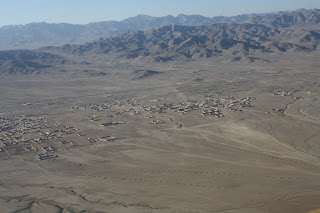I finally got some decent overhead shots of something I've been seeing on practically every flight. You may have to click to enlarge the photos to see what I'm writing about here. But in all of them, you will see a series of circles leading from the riverbed (now completely dried out) to the farms and town. This is the traditional rural irrigation system in Afghanistan. It's actually an underground conduit for the water; the circles are holes dug to allow access so that the farmers can keep the channel clean and free of debris or obstruction. Winter, since it's even drier than other seasons, is the time when they clean out the canals. The villages collectively manage the system - at least they used to. One of the good ideas that turned out to be not so great was that of paying the locals to clean out and maintain the canals, warping the way things work and unnecessarily altering a facet of rural life that had functioned pretty well. You didn't clean out your section of the canal, odds were good that your immediate neighbor downstream was going to whack you upside the head with a shovel to remind you of your responsibility. Afghanistan isn't a water-rich country, though the drought of recent years has been difficult. But as one of the Texan aggies said, "Water is gold" here. Another one of our great ideas, digging wells everywhere to bring the water supply closer, has perversely depleted much of the ground water, creating longer term problems. Many of the local disputes that go on here have nothing to do with any insurgency; they are long-running fights over water and irrigation rights, land titles (which of course didn't always exist), and fights among herders whose sheep decimate grazing land (especially difficult to resolve when the sheep or goats belong to the nomadic Kuchi). So anyway, water's a big deal here, and water dynamics are the key to understanding much of rural village events.
Saturday, January 8, 2011
Subscribe to:
Post Comments (Atom)



No comments:
Post a Comment